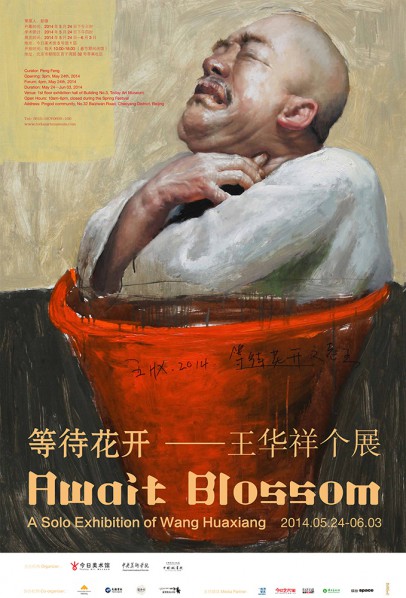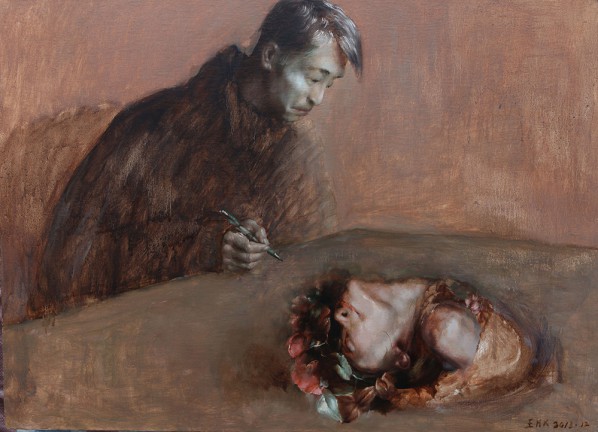
By Peng Feng
Wang Huaxiang’s art is famous for its variations. Small variations occur between each individual work, in spite of stylistic similarities, whereas substantial shifts in style and medium take place every decade. Wang used to create woodcuts in the mid-80s before focusing on oils in the mid-90s, covering such a wide range that seems inconceivable. Wang’s woodcuts are typical modern art while his oil paintings fall into the category of post-modern art. However in around 2005, he stopped creating post-modern oil paintings. This was marked by a solo exhibition “Face-lift—Portraits of Wang Huaxiang’s Arts” at the National Fine Art Museum in 2006, which summarized his post-modern oil paintings. Though the oil paintings were positively received by both the academy and market, he made up his mind to explore onwards. Ever since, he has experimented with conceptual sculptures, installations, performances and paintings, markedly different to the modern woodcuts and post-modern Face-lift series. As we review his recent art practices, we are faced with the difficulty to categorize them by established artistic genres. Wang deliberately avoided stylized arts and endeavored to break the borders in peruse of pure freedom of expression. Contemporary art is typically represented by a status absent of any specific. Within three decenniums, Wang experienced modern art, post-modern art and contemporary art in sequence. Generally, the three artistic styles characterize the historic route that Chinese contemporary art has gone through, which in history was fulfilled by different individual artists. For example, some artists focused on modern art, others would only create post-modern art, while the rest explored contemporary art. Wang has experienced all by himself what a group of artists fulfilled in history. This accomplishment is partly ascribed to the artist’s love of variation and partly to the rapidly changing society. A change-loving artist living in a country undergoing dramatic changes, resulted in a range of seemingly entirely unrelated artworks.

Wang Huaxiang, Oh Series No. 1, 2013; Oil on canvas, 110x80cm

Wang Huaxiang, Oh Series No.2, 2013; Oil on canvas, 110x80cm
However, upon closer inspection, one would find out that the variations in Wang Huaxiang’s arts are not mere coincidences. Modernism was a strategy widely adopted by Chinese artists in the 80s against social realism. As this particular mission was accomplished in the 90s, modernism fell victim to superficial and stale formalism due to the lack of an opposition, while ideas provoked by post-modernism saved art from its crisis. The collages in Wang Huaxiang’s “Face-lift” series, combining East and West, the profound and profane, virtual and reality etc are amongst the very few Chinese paintings that fulfill the criterion of post-modernism, in spite of post-modernism’s controversies as a concept. However even post-modernism fell into the trap of established styles. This is particularly why Wang stopped creating “Face-lift” series. When collage was established as a style, it became a game of formalism in which further practices could only add to the knowledge of Western and Eastern art history.
As Wang Huaxiang gave up on modern and the post-modern styles, his art immediately became contemporary. The greatest distinction between contemporary art and modern or post-modern art is that it could not be defined by a certain style, or rather that it refuses the establishment of style. For example, the sculptures, installations, performances and paintings of Wang would shock or embarrass the viewers for they could not be approached with any established style. In fact, Wang challenges the established vocabulary in the art circle as he banishes himself into an indeterminate status which even oneself knows not the direction or result. As Goethe put it, he no longer looks forward or turns back but concentrates on the moment only to feel the current. Discounting wealth and fame, art is only left with truth. Despite the declining influence of Freudism, its explanation of art as the sublimation of unconsciousness or daydreaming still makes sense. The recent works of Wang are all reflections of his mental activities. Wang does not adopt the method of realism because the most private mental activities have no corresponding representation in reality. Neither does he adopt expressionism because of the pressure its overly serious and direct form of expression imposes on the viewer. Wang ended up with the surrealism but deliberately avoids the stylistic language by applying classical painting techniques in parts of the paintings. It is worth noting that his combination of classical painting techniques and modern style does not result in a post-modern collage but only expresses the sincerest feelings of the artist. As a stringently academically trained painter and art educator, to omit technique would conversely seem out of place. Once again we could discover Wang’s deliberate aversion to established styles. Wang Huaxiang’s did not abandon technique against his will for the contemporary concept-over-technique approach, even if that would cause his works to look less “contemporary”. In turn, this is particularly why Wang creates true contemporary art that falls into no established categories.

Wang Huaxiang, Someday, 2012; Oil on canvas, 110x80cm

Wang Huaxiang, Not Fictitious, 2012; Oil on canvas, 50x70cm
Wang Huaxiang’s insistence on variation is a pursuit of the ultimate truth. This is not to discount the level of authenticity of his early modern woodcuts and post-modern oil paintings, which were indeed authentic at the time of their creation. However, as both the society and the artist change, artistic style would inevitably change correspondingly in pursue of the ultimate truth. Therefore, even though the styles of Wang’s art constantly vary, the impulse to follow truth remains, regardless of aesthetics or morality. It resembles the phenomenological concept of “returning to things themselves”. We are used to view the world with aesthetic or moral concepts regardless of the fact that art is beyond concept. We feel dazzled when we give up prejudices to face the things-in-itself, analogous to that in Plato’s Cave: a slave trapped in a cave takes the shadows on the cave wall as reality. After he is freed from the cave and walks in the sun light, the first sight of the reality makes him dazzled. Wang’s works would dazzle us but help us to overcome the feeling as well.
On 5th May, 2014 at Weixiu Garden in Peking UniversityAbout the exhibition
Curator: Peng Feng
Organizer: Today Art Museum, Central Academy of Fine Arts
Duration: May 24—Jun 03, 2014
Venue: 1st floor exhibition hall of Building No.3, Today Art Museum
Open Hours: 10am-6pm, closed during the Spring Festival
Address: Pingod community, No.32 Baiziwan Road, Chaoyang District, Beijing
Tel: 8610-58760600-100
Courtesy of the artist and Today Art Museum, for further information please visit www.todayartmuseum.com.




























